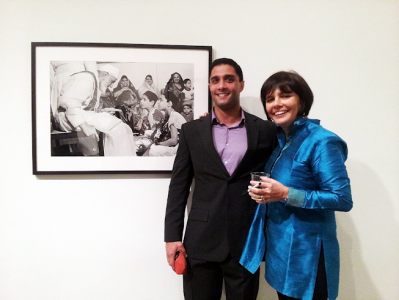What started out as photographer Sooni Taraporevala’s attempt to preserve the essence of a generation evolved into something much greater: an insightful and unprecedented documentation of India’s Parsi Zoroastrians.

Thursday night marked the opening of Taraporevala’s “Parsis, The Zoroastrians of India” at Harvard University’s Carpenter Center for the Visual Arts. “Parsis” is the product of a 35-year exploration in which Taraporevala offers a rare insider’s view of how the Parsis survive today as a religious and ethnic minority of India.
“I didn’t start wanting to make a book or a project,” Taraporevala said. “I wanted to take pictures of my family.”
Zoroastrianism is an ancient religion centered on the teachings of the prophet Zarathustra. Concentrated in Iran and India, Zoroastrianism at its height had millions of followers. In recent years, however, the Zoroastrian community in India has taken a turn toward potential extinction.
Just prior to the gallery opening, Taraporevala, along with Harvard Humanities Center director Homi Bhabha and Harvard professor Sugata Bose, detailed the process of Taraporevala’s work and the cultural implications of the decline in Parsi Zoroastrianism.
“Domestic spaces are where you really excel,” Bhabha said of Taraporevala’s work. “In your photographs, you get a great sense of the special nature of little things.”
Bhabha’s obesrvation resonated with the pieces on display. The collection is a mixture of black and white versus color, portraiture versus candid, public versus private. It encompasses every aspect of Parsi Zoroastrian culture, yet at the same time, it left me contemplating a number of questions. How have all of the people and places changed over such a long period of time? What was the boy feeling as he prepared to become a priest? I wanted to know the stories behind the prints, the names behind the faces.
While Taraporevala’s portraits of historical Zoroastrian figures are artistically profound, the photographs of everyday life are even more remarkable in their representation of the ebb and flow of natural life.
“I would rather photograph ordinary people,” Taraporevala said.
It is in these particular candid photographs that the little things come to life most vividly―the delicate colors of the overcast sky, the industrial beauty of the Godrej typewriter factory, even the childlike innocence of the young boy in a Mickey Mouse shirt at a nearby park.
Taraporevala’s exhibit is aesthetically stunning, but what makes her pieces so much more captivating is the tangible sense of experience and culture within them. Taraporevala did not remain in India for three and a half decades on an assignment photograph the Parsi Zoroastrian community. She remained so she could depict her family, friends and peers as they naturally were in order to preserve the Zoroastrian rituals, traditions, and customs as accurately and poignantly as possible.
“I take a photograph and hope that someone interprets it in a certain way,” Taraporevala said. “I rely on people for the subtext.”
Taraporevala’s exhibition transcends generations and gives a closer insight into how the Zoroastrians have maintained the core elements of their community, even in the face of misfortune and extinction.
As the late Queen frontman Freddie Mercury, who Taraporevala herself described as one of the most well-known Zoroastrians, might have asked, can the Parsi Zoroastrians “live forever” and last as a religious group.
Time will tell if the traditions of the Parsis can last, but through Taraporevala’s exhibition, the little things―the cultural and historical particularities that define Parsi Zoroastrianism―will indeed live forever in the minds and hearts of those who experience her journey through the lens.
“Sooni Taraporevala: Parsis, The Zoroastrians of India” will be on display at the Harvard University Carpenter Center for the Visual Arts through Dec. 20.
This is an account occasionally used by the Daily Free Press editors to post archived posts from previous iterations of the site or otherwise for special circumstance publications. See authorship info on the byline at the top of the page.














Sooni Taraporevala’s exhibit leaves one feeling wonder and empathy for the Parsi Zoroastrian community, both in India and the diaspora. And feeling admiration for Ms Taraporevala, a talented photographer whose skills in this arena are rather unsung, compared to her screenwriting accolades. Other photographers might feel uneasy that their first major exhibit comes when they are in their 50s. But Taraporevala, who published a similar photography book PARSIS a few years ago, is determined and gracious. Hope she exhibits more.
Zoroastrianism is a fascinating religion, which many people of Iranian, Afghan, or Central Asian background (like me) feel an affinity to. Taraporevala’s photographs capture, for people like us who feel this cultural affinity, a sense of closeness to this Indian community (our brothers and sisters) that preserved and adapted their ancient religion until today. If you have any Zoroastrianism in your cultural background, this exhibit will inspire you.